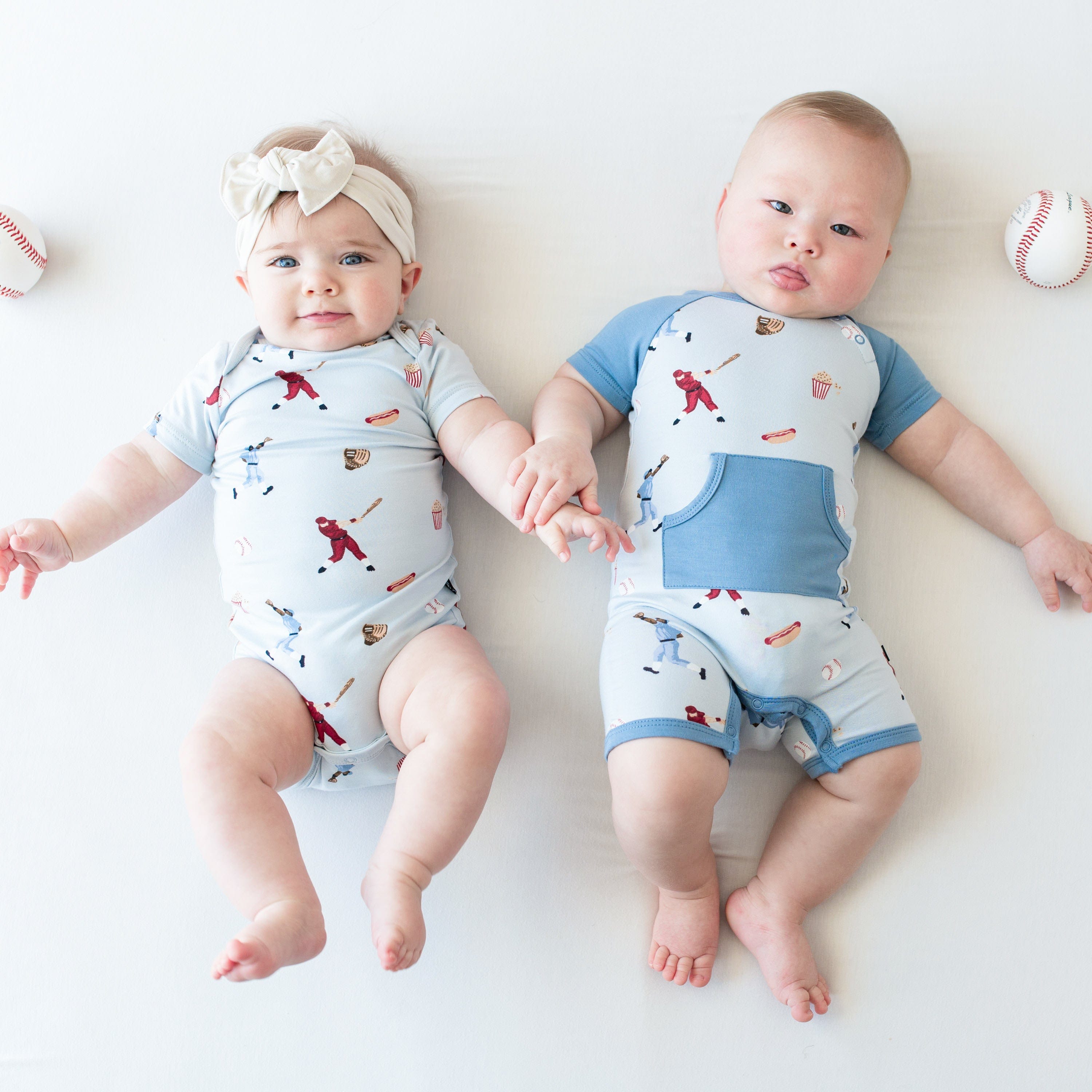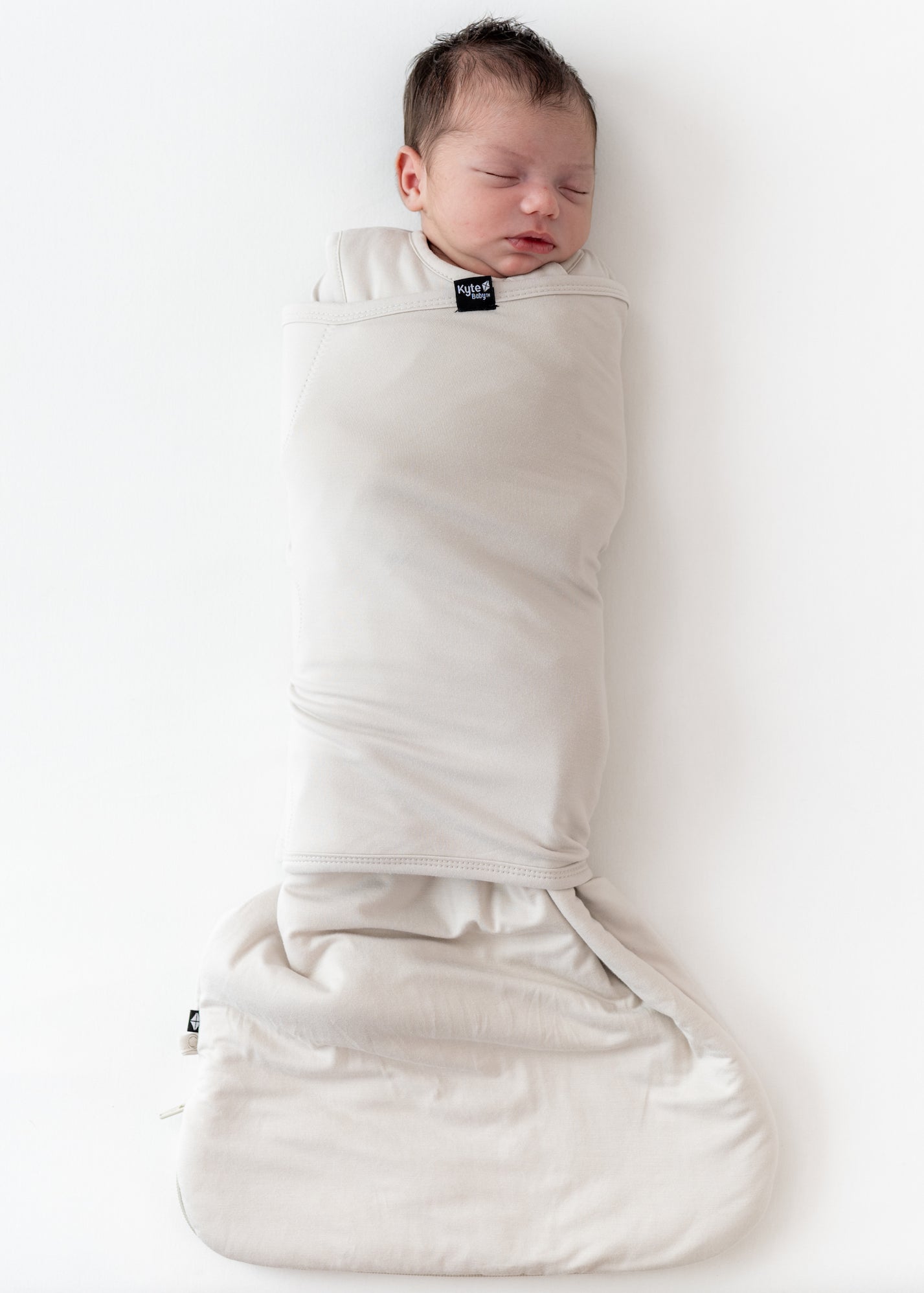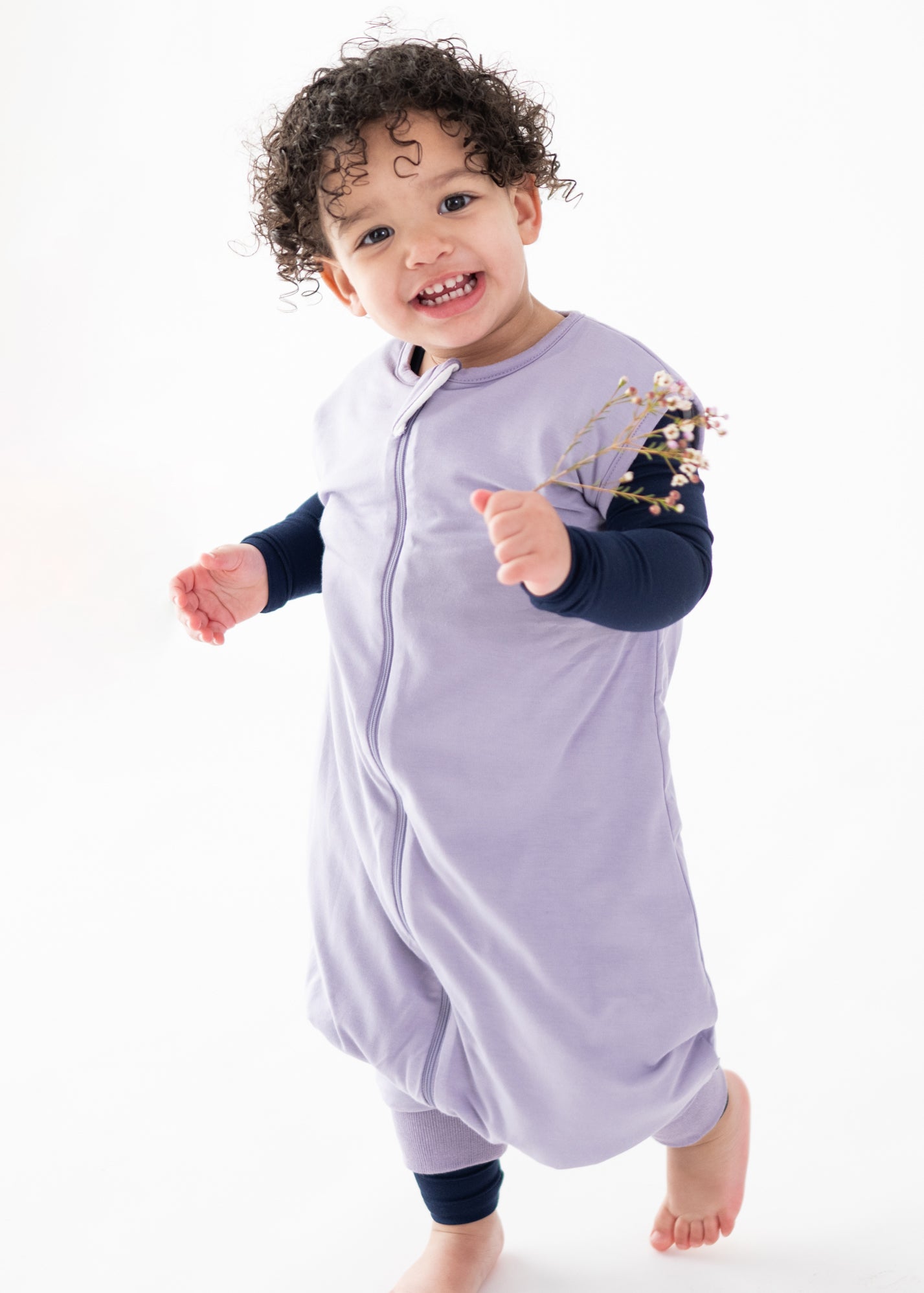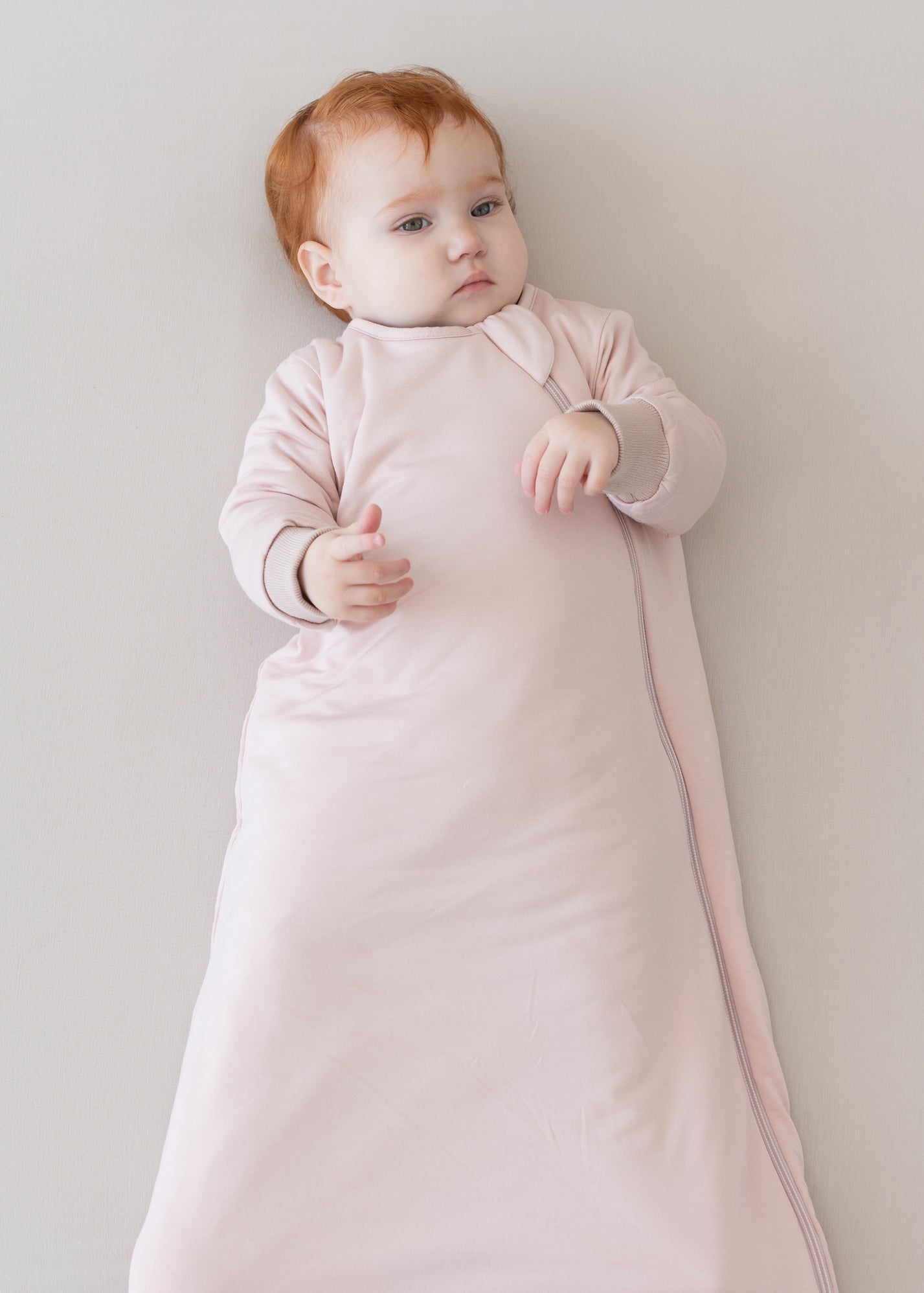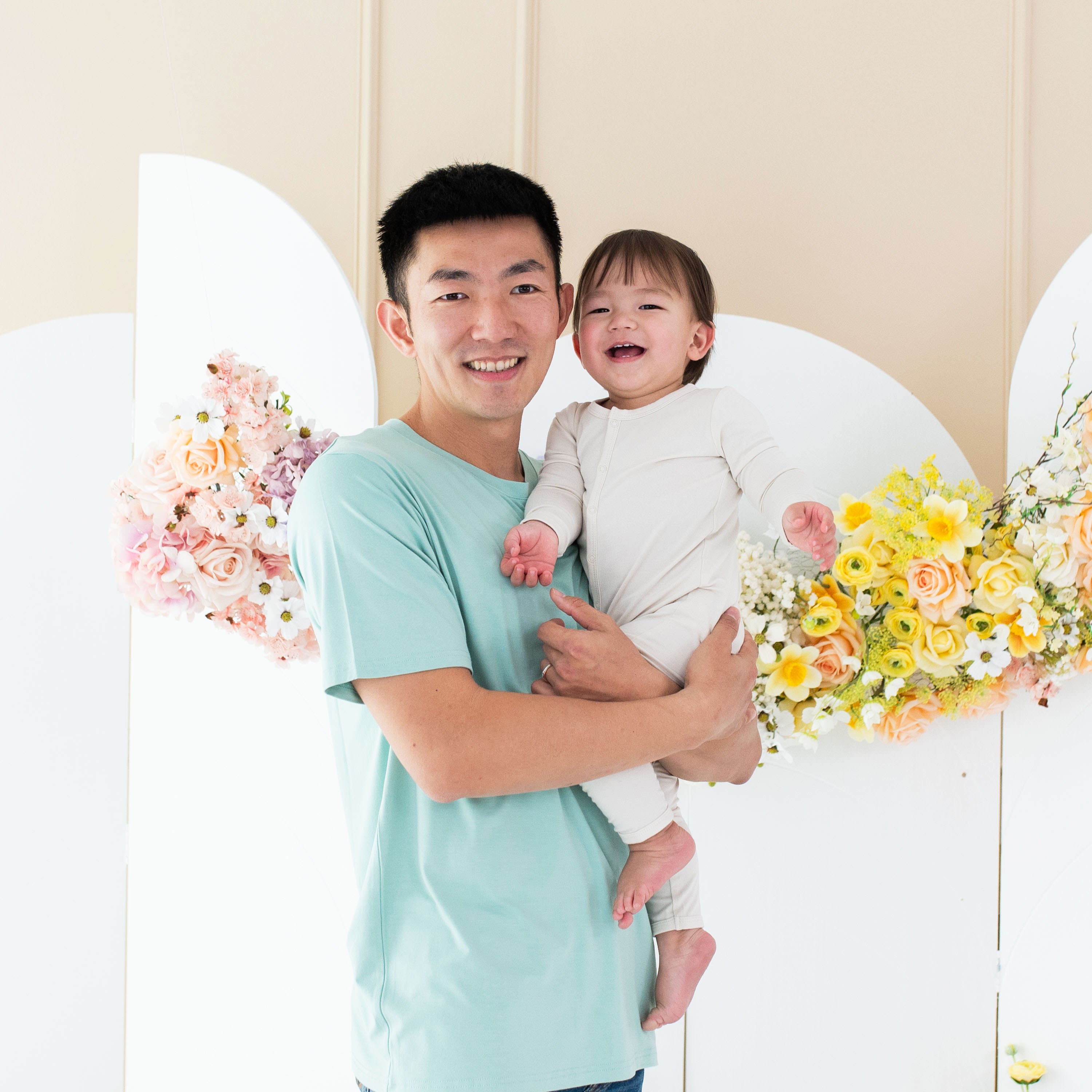
When to stop swaddling is a common topic among moms because there is a lot of information available without a really clear answer. If your baby is currently sleeping well while swaddled, you probably do not want to do anything to change that!
When can you stop swaddling is different than when should you stop swaddling; the short answer is you can stop swaddling whenever you’d like! But when you should stop swaddling your baby is a little different.
Swaddling your baby up like a little burrito is only for a short period of time. In this blog, we will cover why you should try swaddling your baby, how long do you swaddle a baby and how to stop swaddling your baby!
So let's begin:
When To Stop Swaddling Your Baby?

We need to understand what swaddling actually is before we take any step. Swaddling is when your baby is wrapped up in a blanket, swaddle pod, etc with their arms in and either down by their side, across their chest, or in arms up position. The AAP refers to swaddling when their arms are restrained, not when the wings of certain products are wrapped around the chest and arms are free.
This is because when babies roll while swaddled, they aren't able to use their arms and can get stuck in compromising positions for their airway. As long as their chest can expand properly for breathing, wrapping around the chest is just like securing a sleep sack on them without their arms in, just like a wearable blanket.
Certain sources (like wikipedia) may say differently so use your judgement!
Fun fact: swaddling has shown to reduce anxiety levels for babies!
Why Should You Swaddle Your Baby?
If you’re not familiar with the Moro reflex, here’s a great blog about it.
In the meantime, here is the short version: your baby is born with a primitive reflex called the Moro reflex.
This reflex makes them “startle” in a sense and will really disrupt sleep, especially when they’re on their back. This is why swaddling your baby is important! It mimics the womb the environment works to soothe your baby and improves their sleep.
Swaddling your baby gives them the warmth and comfort from the womb and eases their transition into the world.
It is known to calm a fussy baby, reduce nighttime wake-ups, and give the baby a sense of security.
But like all good things, unfortunately, it must come to an end!
Fun Fact: in North America, ~90% of babies are swaddled in the first few months of life!
A quick list to understand when do you stop swaddling a baby for sleep:
● The more reflex integrates as early as 2 months or as late as 6 months (however, the
the more free time they have, and the better rested they are, the less this will disrupt sleep)
● Most babies outgrow their swaddle between 2-4 months (yes, you can buy larger ones,
however, keep in mind that this is just for a short season)
● Your baby is getting one or both of their arms out of the swaddle completely (you can try
swaddling tighter, but if they are still busting out, it is time to go)
● If your baby is showing signs of rolling during floor time or sleep (we will discuss signs of
rolling more)
● You’re getting ready to do some form of sleep training (your baby will need some tools to
help them settle to sleep… their hands are a big help, so keeping them free will ease this
transition)
● Your baby is getting frustrated when being swaddled (remember, this is meant to soothe
your little one-- if it is not working anymore, you can ditch it)
● Your baby is growing too strong or mobile to stay swaddled during sleep (if they are
asking for more mobility, let them have it)
● Suddenly waking up more often while swaddled (if it is not helping your baby sleep for
long stretches of time anymore, then they would probably be more successful in their own without the restriction)
How long should you swaddle your baby for sleep?

The AAP’s official stance is “when an infant exhibits signs of attempting to roll, swaddling should no longer be used.” However, Dr Moon, who is the head of the SIDS task force for the AAP takes it a step further and recommends dropping the swaddle early, by eight weeks of age.
“I would stop swaddling by age 2 months before the baby intentionally starts to try to roll,” Dr Moon says. “If babies are swaddled, they should be placed only on their back and monitored so they don’t accidentally roll over.”
Her stance is that intentional rolling can happen at any time, so by dropping the swaddle early, parents can be proactive instead of reactive. She wants to avoid babies rolling in the swaddle in their sleep and prevent something harmful from happening when parents are also asleep.
If your child is showing signs of rolling before eight weeks of age, then you should discontinue the swaddle then and do not wait for them to reach an older age.
This can seem pretty early if you previously swaddled a baby under the older guidelines of 4+ months, but it is all for safety reasons.
It is also important to note that swaddling does not reduce the risk of SIDS and some babies will actually sleep better without the swaddle. This is definitely a baby-led situation. The risk of SIDS grows with age when swaddled and is higher for infants that are swaddled over 6 months of age.
If you’re unfamiliar with SIDS or SUID (sudden unexpected infant deaths), then you can learn more about that in this article.
Swaddling is a common solution spouted in mom groups when a mother posts about sleep trouble for her infant and it is a great solution when it is still safe to do so. Keep in mind the age and developmental guidelines when suggesting this to a mom with a baby, especially one who is older than 2-3 months.
What are signs of rolling?

I spoke with a pediatric physical therapist who specializes in the development of babies from newborn to age three and asked what are some common signs of a baby who is about to start rolling. This is what she said:
● Getting their legs into a bridge position with knees bent
● Starting to bounce in/out of a bridge
● Arching their back and starting to get partway to their side
● Arching their head to look at a toy over their shoulder
These are obviously not all of the signs your baby could exhibit before mastering how to roll, but it is important to be mindful of the different positions your baby is getting themselves into when considering when to stop swaddling your baby.
A safety note on swaddling your baby:
A swaddled infant should only be placed on their back to sleep. Placing an infant on their side or stomach increases their risk of SIDS. For those put on their bellies, especially babies more than 6 months old, the risk doubled.
Per Claire McCarthy, M.D. for Harvard Medical School, “Although the study can’t tell us exactly why the risk doubled, one can imagine that a tightly swaddled baby might not be able to get her head up if she started having trouble breathing — and if that swaddling blanket came loose and she was face-down, it also might make smothering more likely.”
Also, what you are using to swaddle your baby with should be snug and secure so that it cannot come loose and increase the risk of suffocation or strangulation.
But while it should be snug around the top half of your baby, you will want it to be loose around the hips in order to prevent developmental issues like hip dysplasia.
As always, a swaddled infant is safest when they are placed alone in their sleep space and on their back. If there is a chance that you will fall asleep with your baby in your bed, you should absolutely not swaddle them with their arms in.
As good as swaddling is for your young baby, unswaddled time is equally important! Babies need time to move freely as well so that they can grow stronger and develop their gross motor
skills. If your baby spends all of his sleep AND awake time swaddled, it might be time to gradually stop swaddling during his awake time.
You’ll also want to make sure that they are not overheating in the swaddle. Look for signs like:
● Sweating
● Damp hair
● Heat rash
● Red cheeks
● Heavy breathing
Dr Moon also points out, “Parents should know that there are some risks to swaddling. Swaddling may decrease a baby’s arousal so that it’s harder for the baby to wake up. “That is why parents like swaddling – the baby sleeps longer and doesn’t wake up as easily,” she said. “But we know that decreased arousal can be a problem and maybe one of the main reasons that babies die of SIDS.”
What happens if you swaddle your baby for too long?
There is a need for more research on prolonged swaddling, but at this time there are no adverse effects of swaddling your infant in relation to their development!
As per this study, “Prolonged swaddling in the first year of life did not have any significant impact on children's early mental or psychomotor development.
Additional studies in other settings need to confirm this finding.“While it may not affect their development, prolonged swaddling can increase their risk of
plagiocephaly (or flat head) according to this article.
When should you stop swaddling your baby?

While there are transitional products available to help, that usually means another transition and another disruption to sleep as they get used to something new again.
Babies, just like us, tend to protest change and like what they are familiar with. If you have been swaddling every night for multiple weeks, they have formed a sleep association with that which is now their preference for sleep.
Do not be surprised if your baby does not like having their arms freed overnight! Try sleep bag, use it consistently, and your little one will form another sleep association. If you’re not sure what a sleeping bag is (and it’s different than a swaddle), read this blog for more info.
That is always the key - consistency! It takes time for your child to adjust to new situations like when you stop swaddling; allow for that transitional time, gives your little one grace to get used to something new again!
If your little one is uncomfortable in their sleep space, keep trying. Put them in their sleep space often while they are not swaddled. Warm it up with a heating pad (but be sure to check the temperature before laying them down on it).
You can also sleep with their sheet or sleep bag for a few nights before you put them in it. You can also utilize some gentle sleep training methods like pick up put down or shush/pat.
When you are transitioning baby out of a swaddle, you will want to make sure that whatever you are transitioning them into fits well and according to the manufacturer’s instructions. For instance, for a Kyte BABY sleep bag, it should be loose fitting around the hips and legs to allow for proper hip development.
It should have room in the arms for growth and it should fit well without a lot of extra room around the neck so that it cannot ride up and cover the baby's mouth or nose.
How To Stop Swaddling Your Baby: A Step By Step Plan
1) If the product allows, swaddle with one arm out first. In this position, it will allow for some resistance to slow down the startle and gives them a little bit of freedom instead of too much at one time.
2) Do this for a few nights to allow your little one to adjust and then move on to having both arms out. Again, if your swaddle allows, you can leave their chest wrapped up snug (but arms free and hips loose).
3) After a few nights of having both arms out, you can leave the chest a little more loose (not loose enough to come undone, just not wrapped as tightly).
4) Then you can transition into a wearable blanket, like a Kyte BABY sleep bag.
It is important to start this at night when your baby’s drive to sleep is the highest. If you start at nap time, you will likely have an overtired baby at bedtime which does not bode well for sleep during a transitional period!
If your baby has difficulty sleeping with both arms out of the swaddle and they are not quite ready for the transition, you can use different transitional pieces that still muffle the reflex while allowing them to be unswaddled. A Kyte BABY sleep bag is made of heavier material that is so soothing and calming when you stop swaddling your baby.
It is important to note that if your child suddenly rolls during playtime or in their sleep, there is no time to gradually wean the swaddle. At that point, the transition needs to happen cold turkey.
That may mean a few rough nights of sleep as your child adjusts, but it is recommended to not go back to the swaddle once that development happens. It will take time and consistency to form those new sleep associations!
This is why they recommend being proactive so that you can plan the transition as opposed to reacting when they suddenly decide to become more mobile.
A bonus option plan:
If your child is not rolling yet and is still younger than 8 weeks, you can follow the “partial night” the principle which means you can unswaddle/leave arms out for part of the night and then swaddle them back up for the second half of the night.
Eventually, they may be able to go the full night without the swaddle, if you are lucky. Or you can set a cut off each night and extend it, little by little until they are going the whole night without the swaddle!
What else can you do to help the transition out of the swaddle?

Using white noise is a great way to calm a baby who is waking often from their Moro reflex. It is a great sleep cue as well as helps to mimic the womb because it is definitely loud in there (like 80 decibels loud).
Rocking is another way to mimic the womb environment. There are bassinets on the market that allow for gentle motion. If they continue to struggle with the transition, you can offer a pacifier but keep in mind that when it falls out, they may need you to replace it for them.
You will also want to create a consistent bedtime routine before you begin the transition. This helps to build other sleep cues outside of the swaddle and can reduce the disruption to their sleep (though it may still be a little tough initially).
Timing sleep well is beneficial for helping them go to sleep without the swaddle.
If your baby is under tired or overtired, they will have a harder time falling asleep because they will either not have enough sleep pressure built (under tired) or cortisol will be higher making it harder for them to accept sleep (overtired). If they are out of the swaddle, you will want to check the room temperature or use an appropriate tog in your Kyte BABY sleep bag.
If they are used to being warm, snug, and cozy in their swaddle, you will want to recreate that with the right thickness of sleep bag!
Remember that a sleeping bag (sleep sack, wearable blanket) is a proven way to keep your sleep space safe when you stop swaddling your baby. It is much safer than using a loose blanket in the crib when you are wanting to keep your little one warm and cozy.
When introducing something new, like a sleeping bag, you will want to introduce it for nights first then naps the following day. The more often you use it, the quicker they will form a positive sleep association with it.
This cues them for sleep and the more they know it is coming, the more they will accept it! This means more peaceful sleep routines for you and baby.
At the end of the day… or night, swaddling can be a great tool for your little one!
Remember that it can help prevent them from startling themselves awake which means more peaceful sleep for both you and baby. However, swaddling should be done properly and safely while also giving them a lot of unswaddled time. The earlier you transition out of the swaddle, the better. If you can be mindful of making a gradual transition, that will make it as easy as possible for everyone involved!
Be mindful of signs your little is showing of beginning to master different developmental positions, including rolling to their side or belly. But also keep in mind the risk of SIDS while swaddled increases with age. When to stop swaddling is best done earlier than later!
A gradual transition when you stop swaddling your baby to sleep would include slowly removing pieces of the swaddle until they are ready to sleep in a wearable blanket (since that is proven to be safest for baby). Not all babies respond to gradual change though, and some do best cold turkey-- use your judgement, you know your baby best!
Remember the other tools to use to ease the transition as well such as white noise, a consistent bedtime routine, a good sleep schedule, a pacifier, and rocking. And as always, time is your friend! They will adjust and get back to sleeping those long stretches you had come to love while they were swaddled. Be as consistent as possible during this time and it will pay off when you stop swaddling your baby.
Author Bio: Ashley Olson is a certified pediatric sleep consultant, owner of Heaven Sent Sleep, and passionate about helping new parents, experienced parents, desperate and sleep-deprived parents form healthy sleep habits for their
children.
She has over 3 years of experience in working with families and has completed over 150 hours of coursework plus continuing education related to infant
and toddler sleep. The focus of her work is on fostering a routine that grows your bond with your child while improving their sleep habits. She specializes in custom sleep plans and one on one support in changing sleep practices!


